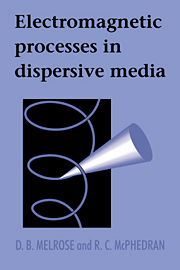Part Five - Specific Emission Processes
Published online by Cambridge University Press: 27 October 2009
Summary
Specific emission and absorption processes may be classified in several different ways. The presentation here is based on the nature of the extraneous current that acts as the source term for the emission. The simplest emission processes are “direct” emission in which the current is due solely to the motion of the emitting particle. The specific direct emission processes discussed here are (i) Cerenkov emission, which occurs for a particle in constant rectilinear motion at greater than the phase speed of the emitted wave, (ii) bremsstrahlung, which results from the accelerated motion of an electron due to the influence of the Coulomb field of an ion, and (iii) gyromagnetic emission, which is due to the accelerated motion of a particle in a magnetostatic field. To each of these processes there is a corresponding absorption process, and negative absorption is possible for both the Cerenkov and gyromagnetic processes. Another class of emission processes corresponds to scattering of waves by particles. The unscattered wave perturbs the orbit of the particle, and the emission due to this perturbed motion corresponds to the generation of the scattered radiation. Non-linear plasma currents need to be taken into account in treating scattering in a plasma. The non-linear currents allow another class of emission processes that are attributed to wavewave interactions, which include a variety of processes such as frequency doubling in non-linear optics and radiation from turbulent plasmas.
Information
- Type
- Chapter
- Information
- Publisher: Cambridge University PressPrint publication year: 1991
